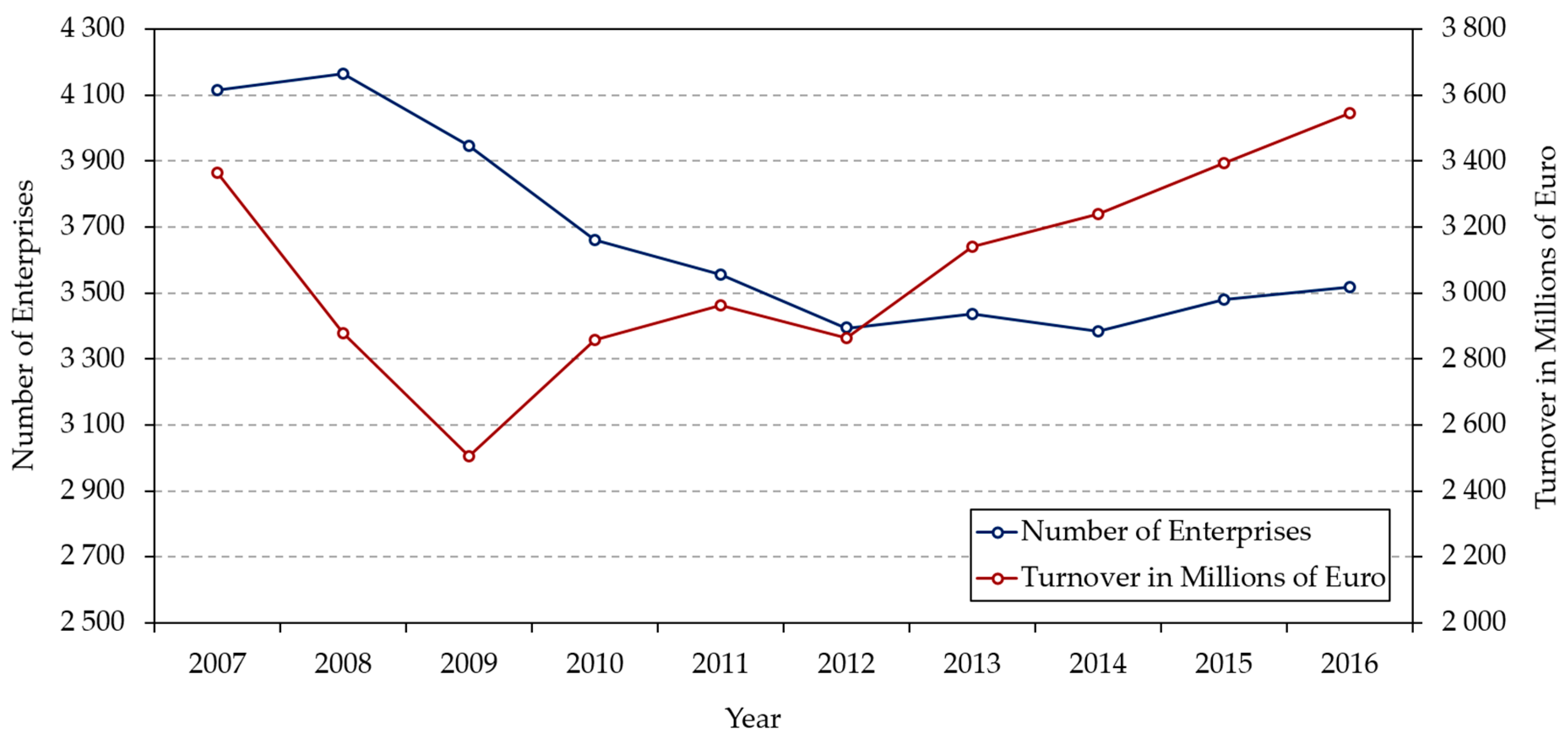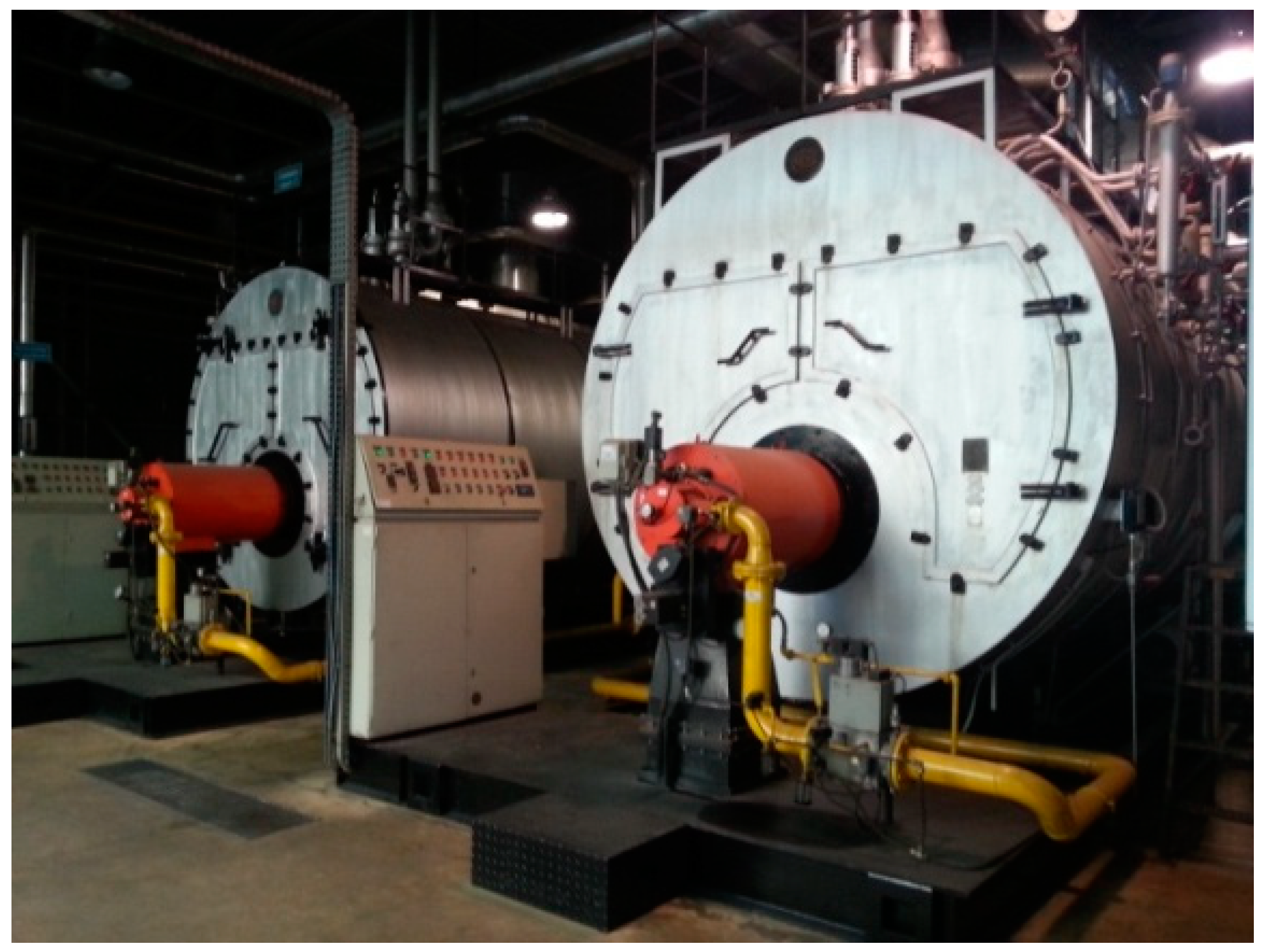Technological Innovation in Biomass Energy for the Sustainable Growth of Textile Industry
Abstract
:1. Introduction
2. State-of-The-Art
3. Materials and Methods
4. Results and Discussion
5. Conclusions
Author Contributions
Funding
Conflicts of Interest
References
- Zuberi, M.J.S.; Bless, F.; Chambers, J.; Arpagaus, C.; Bertsch, S.S.; Patel, M.K. Excess heat recovery: An invisible energy resource for the Swiss industry sector. Appl. Energy 2018, 228, 390–408. [Google Scholar] [CrossRef]
- Lee, I.; Lee, K. The Internet of Things (IoT): Applications, investments, and challenges for enterprises. Bus. Horiz. 2015, 58, 431–440. [Google Scholar] [CrossRef]
- Ko, S.; Lautala, P.; Handler, R.M. Securing the feedstock procurement for bioenergy products: A literature review on the biomass transportation and logistics. J. Clean. Prod. 2018, 200, 205–218. [Google Scholar] [CrossRef]
- Nunes, L.J.R.; Godina, R.; Matias, J.C.O.; Catalão, J.P.S. Economic and environmental benefits of using textile waste for the production of thermal energy. J. Clean. Prod. 2018, 171, 1353–1360. [Google Scholar] [CrossRef]
- Perea-Moreno, A.-J.; Perea-Moreno, M.-Á.; Hernandez-Escobedo, Q.; Manzano-Agugliaro, F. Towards forest sustainability in Mediterranean countries using biomass as fuel for heating. J. Clean. Prod. 2017, 156, 624–634. [Google Scholar] [CrossRef]
- Ioannou, K.; Tsantopoulos, G.; Arabatzis, G.; Andreopoulou, Z.; Zafeiriou, E. A Spatial Decision Support System Framework for the Evaluation of Biomass Energy Production Locations: Case Study in the Regional Unit of Drama, Greece. Sustainability 2018, 10, 531. [Google Scholar] [CrossRef]
- Athari, H.; Soltani, S.; Rosen, M.; Mahmoudi, S.; Morosuk, T. Thermodynamic Analysis of a Power Plant Integrated with Fogging Inlet Cooling and a Biomass Gasification. Sustainability 2015, 7, 1292–1307. [Google Scholar] [CrossRef] [Green Version]
- Han, G.; Martin, R. Teaching and Learning about Biomass Energy: The Significance of Biomass Education in Schools. Sustainability 2018, 10, 996. [Google Scholar] [CrossRef]
- Filipe dos Santos Viana, H.; Martins Rodrigues, A.; Godina, R.; Carlos de Oliveira Matias, J.; Jorge Ribeiro Nunes, L. Evaluation of the Physical, Chemical and Thermal Properties of Portuguese Maritime Pine Biomass. Sustainability 2018, 10, 2877. [Google Scholar] [CrossRef]
- Yub Harun, N.; Parvez, A.; Afzal, M.; Yub Harun, N.; Parvez, A.M.; Afzal, M.T. Process and Energy Analysis of Pelleting Agricultural and Woody Biomass Blends. Sustainability 2018, 10, 1770. [Google Scholar] [CrossRef]
- Li, M.; Luo, N.; Lu, Y.; Li, M.; Luo, N.; Lu, Y. Biomass Energy Technological Paradigm (BETP): Trends in This Sector. Sustainability 2017, 9, 567. [Google Scholar] [CrossRef]
- Ren, J.; Dong, L. Evaluation of electricity supply sustainability and security: Multi-criteria decision analysis approach. J. Clean. Prod. 2018, 172, 438–453. [Google Scholar] [CrossRef]
- Hübler, M.; Löschel, A. The EU Decarbonisation Roadmap 2050—What way to walk? Energy Policy 2013, 55, 190–207. [Google Scholar] [CrossRef] [Green Version]
- Mousa, E.; Wang, C.; Riesbeck, J.; Larsson, M. Biomass applications in iron and steel industry: An overview of challenges and opportunities. Renew. Sustain. Energy Rev. 2016, 65, 1247–1266. [Google Scholar] [CrossRef]
- Fragkos, P.; Tasios, N.; Paroussos, L.; Capros, P.; Tsani, S. Energy system impacts and policy implications of the European Intended Nationally Determined Contribution and low-carbon pathway to 2050. Energy Policy 2017, 100, 216–226. [Google Scholar] [CrossRef]
- Outlook, Southeast Asia Energy. World Energy Outlook 2013; Organization for Economic: Paris, France, 2013; ISBN 978-92-64-20130-9. [Google Scholar]
- Outlook, Southeast Asia Energy. Energy Balances of Non-OECD Countries 2013; OECD Publishing: Paris, France, 2013; ISBN 978-92-64-20306-8. [Google Scholar]
- Heubaum, H.; Biermann, F. Integrating global energy and climate governance: The changing role of the International Energy Agency. Energy Policy 2015, 87, 229–239. [Google Scholar] [CrossRef] [Green Version]
- Guilhermino, A.; Lourinho, G.; Brito, P.; Almeida, N. Assessment of the Use of Forest Biomass Residues for Bioenergy in Alto Alentejo, Portugal: Logistics, Economic and Financial Perspectives. Waste Biomass Valoriz. 2018, 9, 739–753. [Google Scholar] [CrossRef]
- Database—Eurostat. Available online: https://ec.europa.eu/eurostat/web/environmental-data-centre-on-natural-resources/data/database (accessed on 9 October 2018).
- Eurostat Energy Balance Sheets 2016 DATA. Available online: https://ec.europa.eu/eurostat/web/products-statistical-books/-/KS-EN-18-001?inheritRedirect=true (accessed on 19 January 2019).
- Godina, R.; Nunes, L.J.R.; Santos, F.M.B.C.; Matias, J.C.O. Logistics cost analysis between wood pellets and torrefied Biomass Pellets: The case of Portugal. In Proceedings of the 2018 7th International Conference on Industrial Technology and Management (ICITM), Oxford, UK, 7–9 March 2018; pp. 284–287. [Google Scholar] [CrossRef]
- Proskurina, S.; Heinimö, J.; Schipfer, F.; Vakkilainen, E. Biomass for industrial applications: The role of torrefaction. Renew. Energy 2017, 111, 265–274. [Google Scholar] [CrossRef] [Green Version]
- Eurostat—Data Explorer. Available online: http://appsso.eurostat.ec.europa.eu/nui/show.do?dataset=sbs_na_ind_r2&lang=en (accessed on 8 October 2018).
- Nunes, L.J.R.; Matias, J.C.O.; Catalão, J.P.S. Analysis of the use of biomass as an energy alternative for the Portuguese textile dyeing industry. Energy 2015, 84, 503–508. [Google Scholar] [CrossRef]
- Gotzens, F.; Heinrichs, H.; Hake, J.-F.; Allelein, H.-J. The influence of continued reductions in renewable energy cost on the European electricity system. Energy Strategy Rev. 2018, 21, 71–81. [Google Scholar] [CrossRef]
- Nunes, L.J.R.; Matias, J.C.O.; Catalão, J.P.S. Economic evaluation and experimental setup of biomass energy as sustainable alternative for textile industry. In Proceedings of the 2013 48th International Universities’ Power Engineering Conference (UPEC), Dublin, Ireland, 2–5 September 2013; pp. 1–6. [Google Scholar]
- Florin, N.H.; Harris, A.T. Enhanced hydrogen production from biomass with in situ carbon dioxide capture using calcium oxide sorbents. Chem. Eng. Sci. 2008, 63, 287–316. [Google Scholar] [CrossRef]
- Kobayashi, N.; Guilin, P.; Kobayashi, J.; Hatano, S.; Itaya, Y.; Mori, S. A new pulverized biomass utilization technology. Powder Technol. 2008, 180, 272–283. [Google Scholar] [CrossRef]
- De Lima, L.P.; de Deus Ribeiro, G.B.; Perez, R. The energy mix and energy efficiency analysis for Brazilian dairy industry. J. Clean. Prod. 2018, 181, 209–216. [Google Scholar] [CrossRef]
- Haddad, M.; Abid, S.; Hamdi, M.; Bouallagui, H. Reduction of adsorbed dyes content in the discharged sludge coming from an industrial textile wastewater treatment plant using aerobic activated sludge process. J. Environ. Manag. 2018, 223, 936–946. [Google Scholar] [CrossRef] [PubMed]
- Palamutcu, S. 2—Energy footprints in the textile industry. In Handbook of Life Cycle Assessment (LCA) of Textiles and Clothing; Muthu, S.S., Ed.; Woodhead Publishing Series in Textiles; Woodhead Publishing: Sawsto, UK, 2015; pp. 31–61. ISBN 978-0-08-100169-1. [Google Scholar]
- Lin, B.; Chen, Y.; Zhang, G. Impact of technological progress on China’s textile industry and future energy saving potential forecast. Energy 2018, 161, 859–869. [Google Scholar] [CrossRef]
- Huang, B.; Zhao, J.; Geng, Y.; Tian, Y.; Jiang, P. Energy-related GHG emissions of the textile industry in China. Resour. Conserv. Recycl. 2017, 119, 69–77. [Google Scholar] [CrossRef]
- Hasanbeigi, A.; Price, L. A review of energy use and energy efficiency technologies for the textile industry. Renew. Sustain. Energy Rev. 2012, 16, 3648–3665. [Google Scholar] [CrossRef] [Green Version]
- Çay, A. Energy consumption and energy saving potential in clothing industry. Energy 2018, 159, 74–85. [Google Scholar] [CrossRef]
- Ben Youssef, W.; Maatallah, T.; Menezo, C.; Ben Nasrallah, S. Assessment viability of a concentrating photovoltaic/thermal-energy cogeneration system (CPV/T) with storage for a textile industry application. Sol. Energy 2018, 159, 841–851. [Google Scholar] [CrossRef]
- Nunes, L.J.R.; Matias, J.C.O.; Catalão, J.P.S. Application of biomass for the production of energy in the Portuguese textile industry. In Proceedings of the 2013 International Conference on Renewable Energy Research and Applications (ICRERA), Madrid, Spain, 20–23 October 2013; pp. 336–341. [Google Scholar]
- Douglas, P. Woodward Presidential Address: Industry Location, Economic Development Incentives, and Clusters. Rev. Reg. Stud. 2012, 42, 5–23. [Google Scholar]
- Ribeiro, J.M.C.; Godina, R.; de Matias, J.C.; Nunes, L.J.R. Future Perspectives of Biomass Torrefaction: Review of the Current State-Of-The-Art and Research Development. Sustainability 2018, 10, 2323. [Google Scholar] [CrossRef]
- Busato, P.; Sopegno, A.; Berruto, R.; Bochtis, D.; Calvo, A.; Busato, P.; Sopegno, A.; Berruto, R.; Bochtis, D.; Calvo, A. A Web-Based Tool for Energy Balance Estimation in Multiple-Crops Production Systems. Sustainability 2017, 9, 789. [Google Scholar] [CrossRef]
- Mokhatab, S.; Poe, W.A.; Mak, J.Y. Handbook of Natural Gas Transmission and Processing: Principles and Practices, 3rd ed.; Gulf Professional Publishing: Amsterdam, The Netherlands, 2015; ISBN 978-0-12-801499-8. [Google Scholar]
- McKendry, P. Energy production from biomass (part 1): Overview of biomass. Bioresour. Technol. 2002, 83, 37–46. [Google Scholar] [CrossRef]
- Carneiro, P.; Ferreira, P. The economic, environmental and strategic value of biomass. Renew. Energy 2012, 44, 17–22. [Google Scholar] [CrossRef] [Green Version]









| Monthly Average Values | Annual Average Values | |
|---|---|---|
| Consumption of steam production in m3 (60% of the entire consumption) | 175.000 m3 | 1.925.000 m3 |
| Consumption of steam production in kWh (60% of the entire consumption) | 2.250.000 kWh | 24.750.000 kWh |
| Steam production costs (60% of the entire consumption) | 75.000 € | 825.000 € |
| The cost of kWh | 0.034 €/kWh | |
| Monthly Average Values | Annual Average Values | |
|---|---|---|
| Consumption of steam production in m3 (60% of the entire consumption) | 645.000 kg | 7.095.000 kg |
| Consumption of steam production in kWh (60% of the entire consumption) | 2.250.000 kWh | 24.750.000 kWh |
| Steam production costs (60% of the entire consumption) | 48.375 € | 532.125 € |
| The cost of kWh | 0.024 €/kWh | |
| Natural Gas | Biomass (Pine Woodchips) | |
|---|---|---|
| Annual kWh consumption for steam production | 24.750.000 kWh | |
| Annual steam production costs | 825.000 € | 532.125 € |
| Annual total savings | ±35% | |
| Strengths | Weaknesses |
|---|---|
|
|
| Opportunities | Threats |
|
|
© 2019 by the authors. Licensee MDPI, Basel, Switzerland. This article is an open access article distributed under the terms and conditions of the Creative Commons Attribution (CC BY) license (http://creativecommons.org/licenses/by/4.0/).
Share and Cite
Nunes, L.J.R.; Godina, R.; Matias, J.C.d.O. Technological Innovation in Biomass Energy for the Sustainable Growth of Textile Industry. Sustainability 2019, 11, 528. https://doi.org/10.3390/su11020528
Nunes LJR, Godina R, Matias JCdO. Technological Innovation in Biomass Energy for the Sustainable Growth of Textile Industry. Sustainability. 2019; 11(2):528. https://doi.org/10.3390/su11020528
Chicago/Turabian StyleNunes, Leonel Jorge Ribeiro, Radu Godina, and João Carlos de Oliveira Matias. 2019. "Technological Innovation in Biomass Energy for the Sustainable Growth of Textile Industry" Sustainability 11, no. 2: 528. https://doi.org/10.3390/su11020528
APA StyleNunes, L. J. R., Godina, R., & Matias, J. C. d. O. (2019). Technological Innovation in Biomass Energy for the Sustainable Growth of Textile Industry. Sustainability, 11(2), 528. https://doi.org/10.3390/su11020528







